Introduction
Good morning team! Today, we’re diving into a crucial topic that affects each one of us on the job: Essential Workplace Hearing Protection Guidelines. As we work in environments that may expose us to high noise levels, understanding how to protect our hearing is not just a recommendation—it’s a necessity. Neglecting hearing protection can lead to serious long-term health issues, including hearing loss and tinnitus. Let’s discuss why this is important and how we can implement effective hearing protection practices together.
Understanding Essential Workplace Hearing Protection Guidelines
Hearing protection guidelines are a set of practices and Standards designed to prevent hearing loss in the workplace. They identify when and how to use hearing protection equipment, helping to minimize the risks associated with high noise levels. In many industries, noise is a common hazard that can lead to irreversible damage to our auditory system. It’s important to understand that hearing is often taken for granted until it’s too late.
One common misconception is that hearing protection isn’t necessary unless the noise level is extremely high. However, even moderate noise exposure over time can contribute to hearing loss. It’s essential to recognize the cumulative Effects of noise and take action before issues arise.
Key Hazards, Risks, and Safety Considerations
Noise-induced hearing loss (NIHL) is one of the most significant risks we face in our work Environment. Some of the specific Hazards include:
- High Noise Levels: Prolonged exposure to sounds above 85 decibels can lead to permanent hearing damage.
- Intermittent Noise: Even short bursts of high noise can be damaging, especially if they occur frequently throughout the day.
- Lack of Awareness: Employees may not be aware of the noise levels in their work area or the need for protection.
Ignoring these hazards can lead to serious consequences, including:
- Permanent hearing loss
- Tinnitus (ringing in the ears)
- Increased difficulty in communication, leading to accidents and injuries
Best Practices, Procedures, & Actionable Advice
Now that we understand the risks, let’s talk about how we can protect ourselves. Here are some Best Practices and Procedures to follow:
1. Assess Noise Levels
Regularly assess the noise levels in your work area using a sound level meter. If noise levels exceed 85 dBA, it’s time to implement hearing protection measures.
2. Use Appropriate Hearing Protection
Choose the right hearing protection based on the noise levels and type of work. Options include:
- Earmuffs: Provide a good seal around the ears and are suitable for high noise levels.
- Earplugs: More discreet and can be effective for lower noise levels.
- Custom-fit devices: Tailored for individual needs and provide optimal protection.
3. Proper Use and Maintenance
Ensure that hearing protection devices are worn correctly and maintained:
- Inspect equipment for damage before each use.
- Clean earplugs regularly to prevent ear infections.
4. Training and Awareness
Participate in Training sessions that focus on the importance of hearing protection. Encourage discussions about personal experiences with noise hazards.
5. Encourage Reporting
Encourage employees to report any noise-related issues or discomfort they experience. Addressing these concerns promptly can prevent further risks.
Case Study: Real-World Incident
Consider a manufacturing facility where a worker consistently ignored the use of earmuffs in a high-noise area. Over time, he developed significant hearing loss, which not only affected his quality of life but also his ability to communicate with colleagues safely. This incident led to increased awareness within the company and a renewed focus on hearing protection guidelines.
Regulations, Standards, and Compliance
It’s crucial to stay updated with relevant Regulations such as those set by OSHA (Occupational Safety and Health Administration). osha mandates that employers must provide hearing protection if noise exposure exceeds the permissible limits. Compliance with these standards is not just about following the law; it’s about ensuring the Safety and well-being of all employees.
Understanding and adhering to these regulations protects employees and fosters a culture of safety within the workplace.
Employee Engagement & Discussion
Let’s discuss this further. What safety challenges have you encountered related to hearing protection? Have you ever felt discomfort or experienced any issues related to noise? Sharing your experiences can help us improve our safety protocols.
Conclusion & Key Takeaways
In conclusion, protecting our hearing is vital for maintaining our overall health and safety in the workplace. By following the essential workplace hearing protection guidelines we discussed today, we can significantly reduce the risk of hearing loss. Remember, compliance with safety standards, proper use of protective equipment, regular training, and open communication are key components in safeguarding our hearing.
Thank you all for your attention and commitment to ensuring our workplace remains a safe environment. Let’s prioritize our safety and look out for one another!


